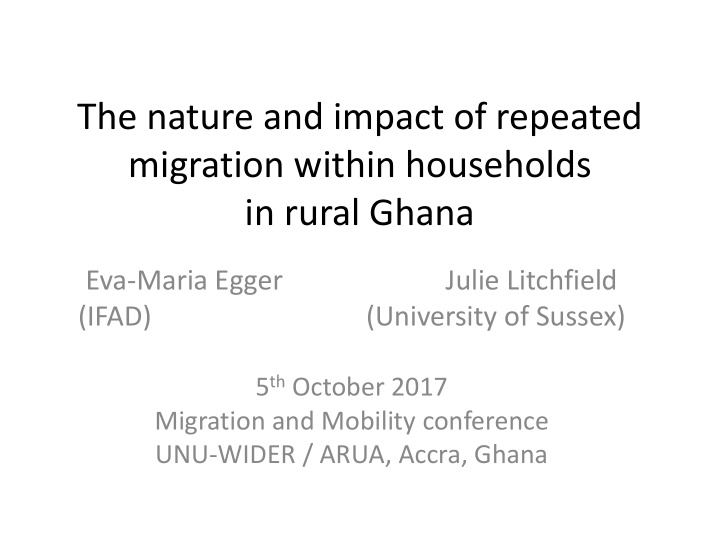



The nature and impact of repeated migration within households in rural Ghana Eva-Maria Egger Julie Litchfield (IFAD) (University of Sussex) 5 th October 2017 Migration and Mobility conference UNU-WIDER / ARUA, Accra, Ghana
Motivation – Open question whether migration has positive or negative impact on sending household empirical evidence needed – Migration is a diverse phenomenon. People move for many reasons (work, family, education) and repeatedly and more than one family member might leave. – Within New Economics of Labour Migration (NELM), but allowing for this diversity – 1 st migration specific panel study for Ghana
Research question – Are new migrants different from the previous migrants of same household? – How does having a new migrant affect the welfare of households who already engage in migration?
Data • Household panel 2013 and 2015 in five regions of Ghana • Collected by the Migrating out of Poverty project / University of Ghana, Legon (supported by University of Sussex and funded by DFID) • Focus on migration: – Oversample households with migrants – Questionnaire covers migration history, remittances, and return migrants
Survey regions Survey regions Other regions
Conceptual framework Household with migration experience and “new” migrant: Household member E is a “new”migrant . Household member D is a returned migrant.
Description of new migrants and their households • New migrant households: larger, family farmers, more of their migrants have job, more have returnee • New migrants: younger generation, straight from education or unpaid work, move for work, education, marriage, few and low remittances, lower moving costs • All migrants: permanent and migration is financed with savings, i.e. credit constraint environment
Impact of new migrant on welfare Methodology ∆𝑍 𝑗,𝑢 = 𝛾 1 𝑂𝑓𝑥𝑁𝑗 𝑗 + 𝛾 2 ∆𝑌 𝑗,𝑢 + 𝛾 3 ∆𝑀𝑁 𝑑,𝑢 + ∆𝜗 𝑗,𝑢 • First difference model of wealth index (Y) on indicator for new migrant (NewMig) and observable household (X) and community characteristics (LM) • Endogeneity: Reverse causality and selection – 1 st difference takes care of time-invariant unobservables – Baseline entropy balancing weights reduce selection by making households look comparable
Outcome variable: Asset index • Composite measure of housing quality (number of rooms, presence of bathroom and toilet, wall material, floor material) • Computed using Multiple Correspondence Analysis (similar to Principle Component or Factor Analysis)
Results
Interpretation • Asset index changes slowly and tends to rather capture increase than decline • Short period might also imply that positive effects of remittance receipt haven’t materialised yet • Low costs of new migrants’ move and low remittances means no loss in labour • Financing of migration through savings means savings cannot be used for investments
Conclusion • New panel study of migration in Ghana. • Repeated migration patterns and different motivations for migration within the same household. • `New’ migrants often from younger generation, moving relatively more for education and family reasons, pay less for their move, remit rarely and less. • No impact found of having a new migrant on households left-behind who already had engaged in migration. Lower costs and use of savings can explain result. • More longitudinal data and more outcome measures needed for conclusive analysis.
Appendix
Entropy balancing weights • Ex-ante definition of balance: • choose variables and moments (mean, variance…) to be balanced • Compute weights and keep all observations that allow weights. • Treated units have a weight of 1, control according to formula below. • Run weighted least squares regression
Balance statistics
Community shocks
Recommend
More recommend